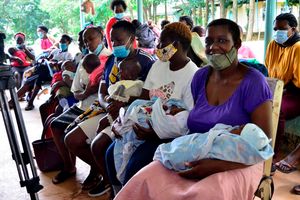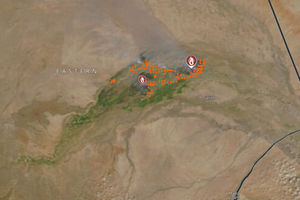Surviving cholera: How Nakuru’s slum residents are fighting the disease

Fauzia Ngina, a cholera survivor, at her house in Kwa Rhonda slums, Nakuru County on September 12, 2024.
What you need to know:
- Between 2017 and 2022, the county reported 394 cholera cases and 17 deaths.
In late 2022, 24-year-old Fauzia Ngina from the Kwa Rhonda slums in Nakuru came close to losing her life from cholera without knowing she was infected.
Living with her young daughter and elderly mother in a cramped dilapidated house, Fauzia had no knowledge of cholera or its symptoms until the disease nearly claimed her life.
Fauzia’s home is a small, fragile structure with cracked walls and a leaking roof, barely large enough to accommodate her family.
Cooking utensils are placed right next to where they sleep, creating additional health risks.

A blocked open drainage with wastewater and other plastic waste that ends up in Lake Nakuru, putting residents at risk of contracting waterborne diseases like typhoid, dysentery, and cholera.
It was in these conditions that Fauzia suddenly fell ill.
“I had diarrhoea and then I started vomiting. Eventually, I fainted. I woke up in a health centre and was told a Good Samaritan had taken me there,” she recalls.
The source of her infection was contaminated water that she bought from a local vendor.
“I had heard of people with similar symptoms, but I didn’t understand the seriousness of the disease or how to protect myself,” she admits.
She says she was unable to afford clean water and found herself vulnerable to the illness.
However, she brightens as she recounts her recovery.

A Nakuru Water and Sanitation Company water selling point in Koinange Estate aimed at improving water supply in Nakuru County due to increased rural-urban migration.
“I felt better after being vaccinated against cholera last year,” she says, adding that she now leads a normal, healthy life after her ordeal.
Her story is not unique in Nakuru.
In the nearby Ponda Mali slums, 55-year-old Protus Sakwa also survived cholera.
He recalls his own experience with a mixture of relief and fear.
“I remember I started vomiting and then had diarrhoea. I was rushed to the hospital and treated on time,” says the shoe cobbler.
Like Fauzia, Protus did not know exactly how he contracted the disease, saying he always practised good personal hygiene and boiled his water, yet still became infected.
The illness left him weak and emaciated.
"I lost so much weight and I didn't know if I would survive," he adds. Today, Protus is healthy but has a warning for others.
“The cholera attack was a wake-up call. I urge everyone to take hygiene seriously because not everyone will be as lucky to survive,” he says.
Cholera outbreaks have plagued Nakuru County almost every year since 2017.
Between 2017 and 2022, the county reported 394 cholera cases and 17 deaths. However, through a combination of public awareness campaigns, surveillance, and vaccination the number of cases has dropped significantly.
According to the County Department of Health, only five cases were reported as of December 2022 with no fatalities; and none have been reported so far in 2024.
Efforts to improve hygiene practices and access to safe water have been critical in controlling the outbreaks.
The county’s health department has emphasised sanitation practices like regular handwashing, inspecting food establishments, and ensuring the safe disposal of human waste. Additionally, oral cholera vaccines have played a significant role in reducing the incidence of the disease.

A woman prepares food in an open eatery along West Road in Nakuru City on October 14, 2024. The devolved unit has intensified inspection to ensure open eateries have access to clean water to deal with waterborne diseases.
However, Nakuru’s rapidly growing population continues to strain resources; particularly clean water access.
The city’s central location also makes it susceptible to importing cholera cases from other regions, especially given the constant flow of people and goods through the city.
Public Health Director Elizabeth Kiptoo acknowledges that while the county has made great strides, challenges remain.
“Our location and ballooning population expose us to the risk of cholera outbreaks,” she says.
Despite ongoing efforts to expand water access, the county still faces a significant gap between supply and demand.
Nakuru Water and Sanitation Company (NAWASCO) estimates the city needs 70,000 cubic metres of water daily, but the current supply is only 40,000 cubic meters. Water shortages are common, with many areas experiencing rationing. The problem is expected to worsen as the city’s population is projected to grow to over 664,000 by 2035.
Many neighbourhoods, including well-off estates like Kiamunyi and informal settlements such as Kwa Rhonda, are not connected to the city’s sewer system, further complicating efforts to maintain public health standards.
Wastewater generated by households—about 300 million liters daily—often ends up in rivers, polluting the city’s primary water sources. This puts residents at constant risk of waterborne diseases like typhoid, dysentery and cholera.
To address these issues, the Nakuru County government has launched several initiatives to improve water infrastructure and sanitation.
Water and Natural Resources Executive Nelson Maara explains that the county is prioritising water infrastructure development to meet the growing demand.
“We have entered into public-private partnerships to revamp aged wastewater treatment and sewerage systems,”says Dr Maara.
The county is also working on separating storm water from wastewater for better filtration and disposal.
Plans are underway to expand Nakuru City’s sewerage system to previously unconnected areas, including informal settlements, and to upgrade existing treatment plants in Kivumbini and Mwariki.
Mr Maara emphasises that improving water and sanitation is key to preventing future cholera outbreaks.
“We are expanding our sewerage systems and water storage to ensure more households have access to clean water,” he explains.
The national government has also played a role in curbing cholera through vaccination campaigns.
In 2023, the Ministry of Health launched a vaccination drive in eight high-risk counties, including Nakuru, where 1.59 million people were vaccinated.
Kenya is using the new oral cholera vaccine, Euvichol-S, which has shown similar efficacy to previous vaccines but has a simplified formulation. The World Health Organization (WHO) recommends two doses of Euvichol-S, which protects for up to two years.
The vaccine has been used successfully in countries like Haiti, South Sudan, and Ethiopia to stop cholera outbreaks.
According to WHO, there were 473,000 cholera cases worldwide in 2022.
In Kenya, more than 12,000 cases and 200 deaths were recorded in 2023, but only 68 cases have been reported in 2024, despite widespread flooding due to heavy rains.
Public health officials attribute the decline in cases to improved sanitation, access to clean water and the vaccination campaign.
Cholera remains a threat in Nakuru County, but with continued efforts to improve water and sanitation infrastructure, raise public awareness, and expand vaccination coverage, the goal is to decrease the incidence of the disease and protect vulnerable populations like Fauzia and Protus from future outbreaks.





